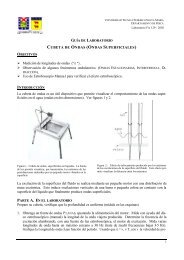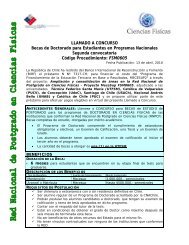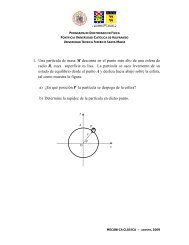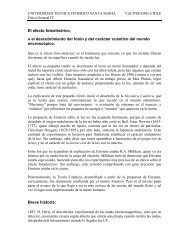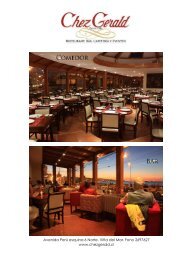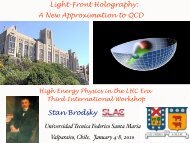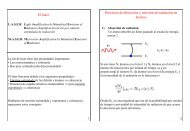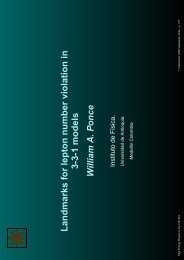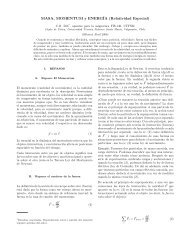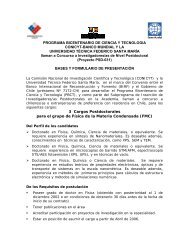Aca - Departamento de Física - Universidad Técnica Federico Santa ...
Aca - Departamento de Física - Universidad Técnica Federico Santa ...
Aca - Departamento de Física - Universidad Técnica Federico Santa ...
Create successful ePaper yourself
Turn your PDF publications into a flip-book with our unique Google optimized e-Paper software.
V Encuentro Sud Americano <strong>de</strong> Colisiones Inelásticas en la Materia<br />
Plasmon excitation in single walled carbon nanotubes by charged particles<br />
S. Segui 1 , D. J. Mowbray 2 , 3 , J. L. Gervasoni 1 , Z. L. Mišković 2 and N. R. Arista 1<br />
1<br />
Centro Atómico Bariloche (CNEA) 8400 S.C. <strong>de</strong> Bariloche, Río Negro, Argentina<br />
2<br />
Department of Applied Mathematics, Univ. of Waterloo, Waterloo, Ontario, Canada<br />
3<br />
Nano-Bio Spectroscopy Group, Depto. <strong>Física</strong> <strong>de</strong> Materiales, Univ. País Vasco, San Sebastián, Spain<br />
email address corresponding author: segui@cab.cnea.gov.ar<br />
The excitation of plasmons in singleand<br />
multi-walled nanotubes has been the<br />
object of several experimental and theoretical<br />
studies in recent years, since it plays an<br />
important role in a variety of interesting<br />
phenomena, such as probing the nanotube<br />
response by EELS, formation of electron<br />
image states, etc.<br />
Due to the geometry of single-walled<br />
nanotubes, and the characteristics of the<br />
electronic structure of carbonaceous<br />
nanostructures (with σ and π orbitals), the<br />
excitation of plasmons is conveniently<br />
<strong>de</strong>scribed by a two-fluids formulation of the<br />
hydrodynamic mo<strong>de</strong>l. In this formulation, σ<br />
and π electrons are treated as separate twodimensional<br />
fluids constrained to the same<br />
cylindrical surface. The electrostatic<br />
interaction between the fluids gives rise to<br />
splitting of the plasmon frequencies into two<br />
groups of distinct energies.<br />
In this work we present a quantization<br />
of the two-fluids hydrodynamic mo<strong>de</strong>l [1].<br />
This procedure allows us to obtain the<br />
average number of plasmons excited by a fast<br />
charged particle impinging on the nanotube at<br />
different positions. We also calculate several<br />
other quantities, such as the stopping power,<br />
energy loss spectra and total energy loss,<br />
which could be compared with experimental<br />
measurements. We study the effect of various<br />
parameters, such as the velocity of the<br />
inci<strong>de</strong>nt particle, the impact parameter, the<br />
inclination of the trajectory with respect to<br />
the tube’s axis, etc. Figure 1 shows the total<br />
energy loss suffered by a proton passing near<br />
a 7 Å radius nanotube, as a function of the<br />
inci<strong>de</strong>nt velocity v, for (a) perpendicular and<br />
(b) oblique trajectory, and different minimum<br />
distances from the tube's axis.<br />
Figure 1. Total energy loss E l o s s versus<br />
speed v for proton trajectory passing near<br />
a SWCNT of radius R=7 Å with an angle<br />
relative to the tube's axis of (a) 90° and<br />
(b) 45°, at the minimum separation of r m i n<br />
= 7.5 Å (top), 8.0, 8.5, 9.0, 9.5, 10.0, and<br />
10.5 Å (bottom).<br />
References<br />
[1] D. J. Mowbray, S. Segui, J. L. Gervasoni, Z.<br />
L. Mišković and N. R. Arista, Phys. Rev. B. 82,<br />
035405 (2010).<br />
49 Valparaíso, Chile



